26
JUN
2017
A First-Look at UX in the JUNGLE
This is a translation of UX in the JUNGLE 不一樣的桌遊開箱文
Self-disclosure: Two members of the PIXNET UX team, including the translator of this article, were former employees of Trend Micro, the company produces UX in the JUNGLE.
The members of PIXNET UX team were happy to play UX in the JUNGLE for the first time. The board game is a product of Trend Education Foundation. We were curious about how the game would show the importance of UX in the product development life cycle. Let’s find out!
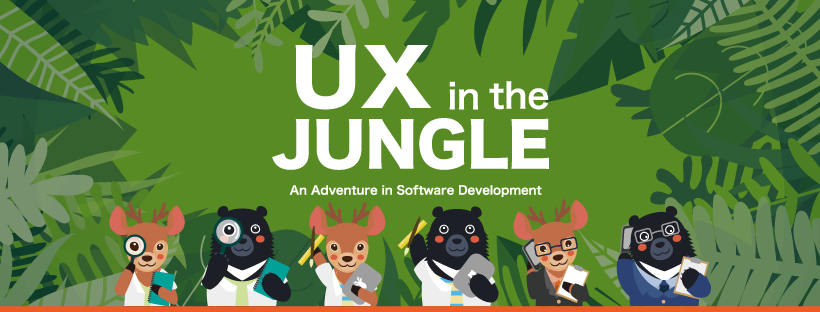
Source: UX in the JUNGLE @ Facebook
The Story
The story was representative of what happens in a software company - developing a mobile game: there were two companies in the JUNGLE, the Deer and the Bear. Both companies were trying to create the next big-hit mobile game. The players represented the UX teams in the companies and their goals were to create the mobile games in a limited time and to satisfy the markets in the most countries (i.e. making the most money).
However, before joining the battle in the JUNGLE, we needed a utility knife and a steady hand to unwrap the package...

The package is quite huge.
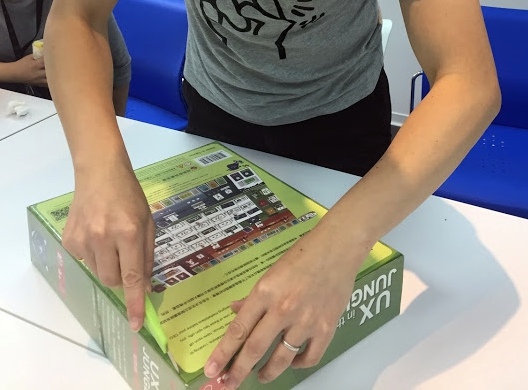
The Unboxing

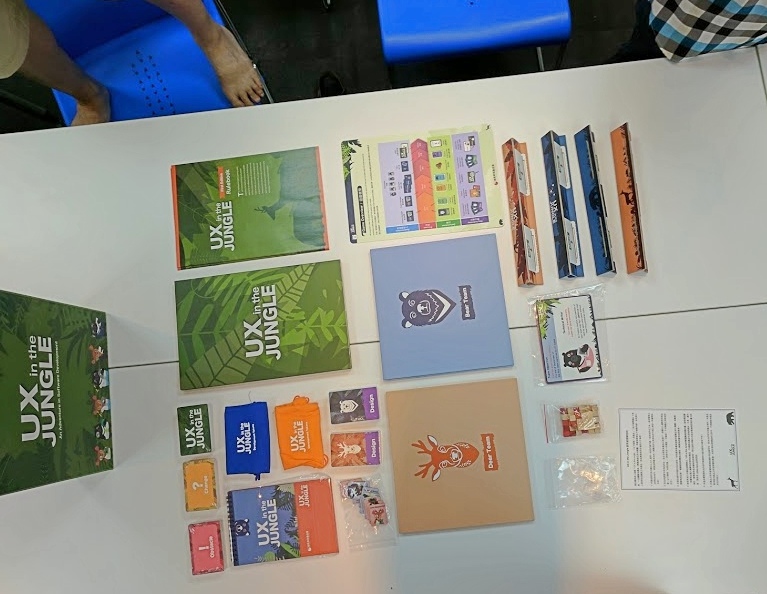
Putting everything on the table.
I seldom played board games and I was shocked by number of items in the package: cards, tokens, cue cards and even an in-game calendar!
Before the Game Began
One should prepare himself/herself before the game begins: read the rulebook and choose your team mates carefully. For the rulebook, you can download an electronic copy online. I was hoping just to have others to read the rulebook and follow their leads during the game, but it turned out that such mindset wouldn’t help you win the game. So choose your teammates carefully.
Another thing to remember is, have a big table ready before you play this game. We needed to combine several tables to place the game comfortably.

Organize Your Team in the JUNGLE
Next what we needed to do was forming two teams.

After that, one needed to select a role in the team. Up to three team members were allowed in a team, and one could choose one of the five roles in the game. There were two UX-related roles among the five available roles: User Researcher and UX Designer, and the other three were Design Manager, Front-End Developer and Technical Writer. Each of them had their own unique abilities to help the team to win the game.
In the beginning we thought User Researcher didn’t have a direct influence on the game, but in the end we realized the role played was important because it could help the team to earn more money in the game!
Whether one was in the software industry or not, the player could learn how each role function in the game, and a product could launch successfully only if the team worked together closely. You could play a different role than your real-life ones to learn what your team members do by playing the game.

Cute role pieces
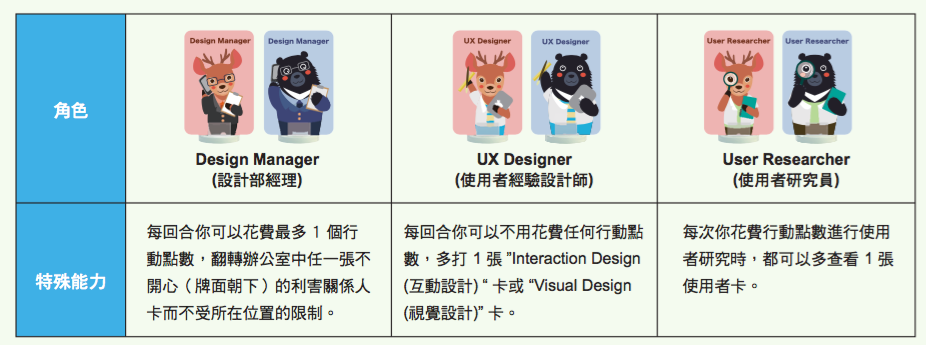
The roles and their abilities in the rulebook.
Ever-Changing Markets in the World
On the jungle board, there were tiles representing the markets in different countries in the world. At first, we put random cards on the tiles to represent different needs from the different markets, eight cards open and eight covered. The symbols on the cards showed various needs from the markets.
Your goal was to develop a mobile game that fit the needs of as many markets as possible, and thus earn more profit. The covered cards were for the team to investigate, that’s when the User Researcher came in. Its ability could help the team to uncover the cards and took an advantage during the game.
The cards in the tiles would change after each player drew a Change card, therefore the team needed to carefully choose the type of the games they were developing.
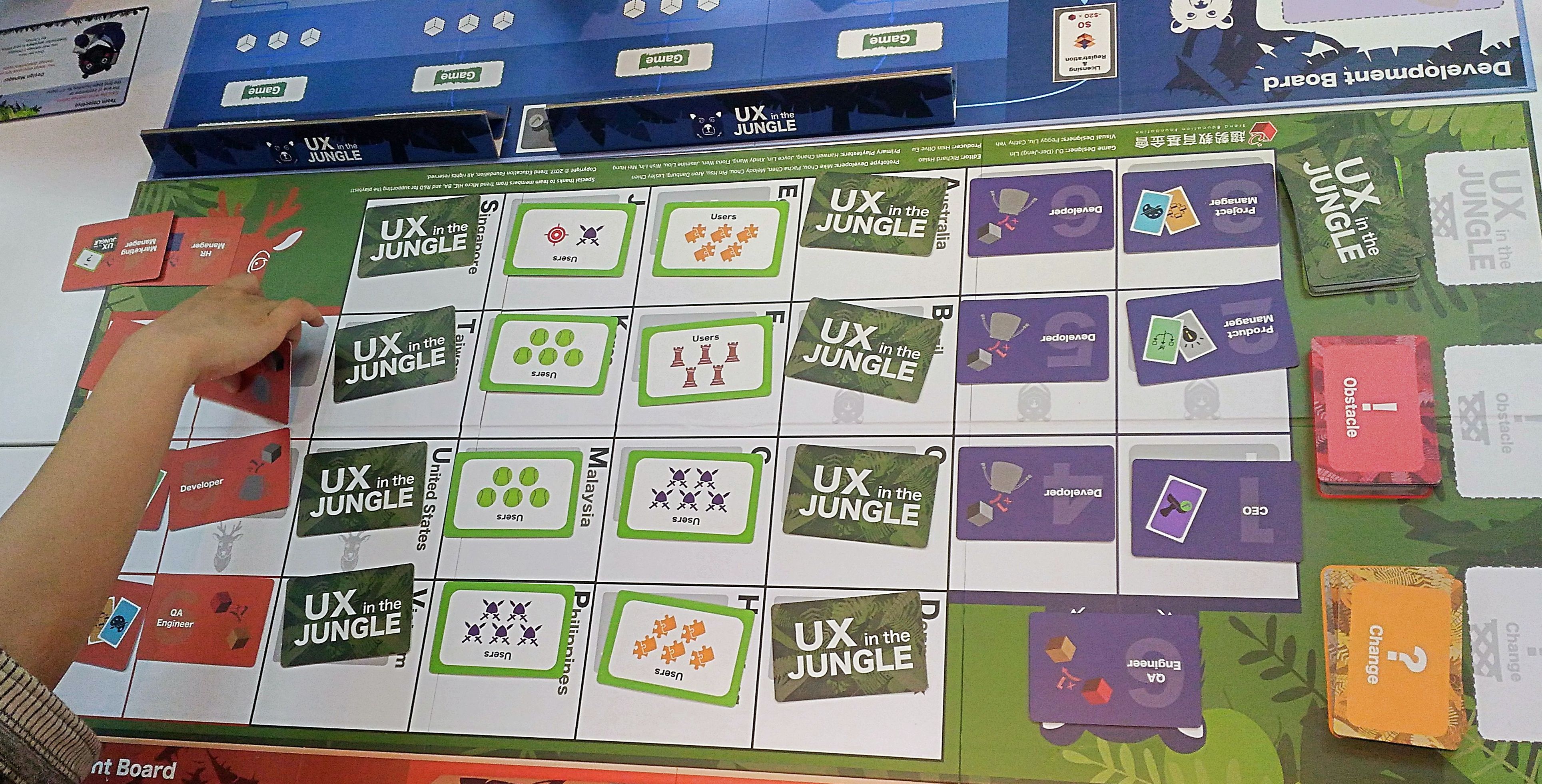
Putting the cards on the tiles. There were eight cards to investigate, the team can learn what would be the hottest game in the world!
Stakeholder Cards
Next to the market tiles were the stakeholder tiles for each team. Each stakeholder had its impact to the development process if the stakeholders were unhappy, and the players needed to “manage” the stakeholders with different roles.

The stakeholders’ tiles on the jungle board.
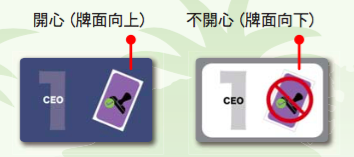
The two sides of a stakeholder card (happy / unhappy)
Read the Rulebook
For the ones who didn’t read the rulebook, a game overview card was ready for them in case a particular information was needed. The game overview helped you to understand the process of the game development: define, design, develop, deploy and deliver. Understanding the process would help you decide your strategy when you played the game.

The game overview card.
The game required significant fundamental knowledge about the game to start playing, but once the game started, you would learn it fairly quick.

We even had a game master to help us understand the rules, but even he needed to study the rulebook during the game.
Define Your Product
The team then needed to decide the type of the game that would be developed. Draw six game cards and keep three. This process made players realize that early in the development cycle, the strategy was always defined by the current market the team was facing at that time. The team had to decide three products (game cards) that fit the markets the best and put the products into development cycle. However, later in the game, we realized the markets kept changing and it was frustrating.

Select three products (game cards) based on the current market needs.
Turns in the JUNGLE
Although the rulebook explained the steps that the player needed to do in each turn, I still recommend the players to have a trial run so that every player can play a turn before the game starts (for real). There are many steps in a turn and you’d need to practice memorizing the steps, especially to lazy plays like me who didn’t read the rulebook in the first place.

Steps in a single turn.
Each player could have up to four Design cards which were required to develope the products in the game. The players needed to draw two Design cards and that’s where the fun was.

Two of the Design cards were the Visual Design card and the Product Endorsement card.

The Design card decks. Players need to draw two cards in each turn.
There were several actions that players could do in the game: traveling between offices around the world, making your stakeholders happy, investigating the needs in different markets and speeding up the development process. Also, there were tokens that representing the development process: unpainted wood tokens and red ones. The unpaint token were good, bug-free deliverable and the red one were bad, buggy deliverable. The “bugs” needed to be taken of before the product release, otherwise they would have a direct impact to the revenue.

Token representing the status of deliverable.

Token are stored in a bag that the players can draw tokens from it.
One of the most impressive cards was the End of the Month card, which are the most unwanted card among all. Whoever drew the card, the time flew by and jumped to the end of the month. But there were only nine months in the game! With the in-game calendar, the deadline to deliver the product (conclude the game), everyone could feel the pressure fell on our shoulders.

End of the Month! card.
It was nerve-racking to draw an End of the Month! card already, if you also saw your opponent were smiling for their victory, you would think it’s getting personal. Nobody liked to lose! It would be the time to realize the projects in the real world is brutal: every detail in the game reflected what would happen in the real projects. The game was so thrilling that we would even give the game a new name: The Blair Witch Project.
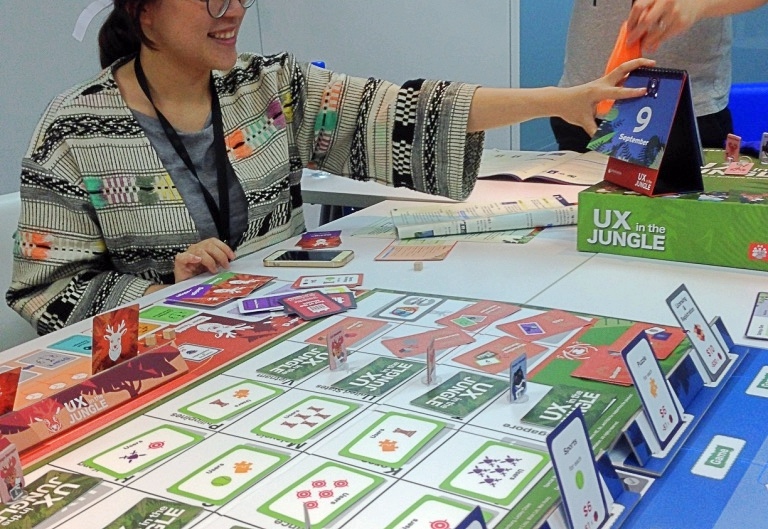
Draw an End of the Month! card and flip the in-game calendar to the next month.
Change is the only constant
Remember that in each turn, the Change cards you drew would cause the markets to change because the cards in the tiles were replaced by the cards you drew. This meant the markets were always changing fast, and the stakeholders of the team would also be unhappy as a result, this would have an impact to the schedule. Therefore, the management of the stakeholders was important in this game.

A Change card is drew during each turn.
Conclusion
This is not a typical “first-look” article, so I would like to stop here. What I learned from this game is the uncertainty of a project, as well as the key to win the game is to understand the needs of the users.
Also, the game is designed to hinder the development of the projects all the time, but this is exactly what happens in the real world before you release a product: free the design, research what the markets need, have the bugs in the product fixed, and the most important of all, make your stakeholders happy.
There will be lots of exploration, epiphany, regret and joy in this game. One last thing, don’t forget to put every piece of the game back into the box. Every project needs a proper closure, even for a game so inspirational.

A proper closure is to put everything back into the box in a proper order.
I can’t recommend this game to you. It is like the Sesame Street in the UX industry - a good introduction to people who are interested in the UX.
For any inquiry, please head to UX in the JUNGLE Facebook page for more information.
Witten by: Isabel
Translated by: Jack
推薦閱讀:









